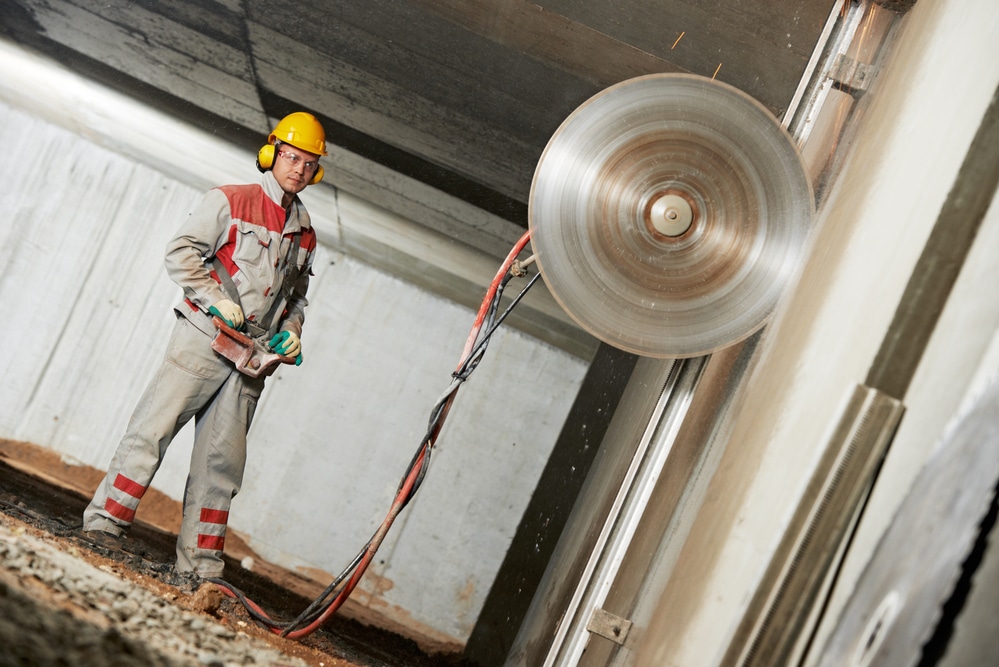Concrete wall sawing is loud and messy, and it can be dangerous without the right tools and training. That is why it’s essential to work with a concrete wall sawing professional for all of your wall sawing needs.
Concrete wall sawing has many different purposes, but generally speaking, it is used to remove sections of concrete from existing structures to create openings of virtually any size or shape.
Let’s take a look at the process for creating an opening for a door in a concrete wall so you can get a better idea of what the process involves.
Concrete Wall Cutting for Doors
When removing a section of concrete to install a door, a concrete wall sawing professional will make a series of cuts to create an opening of the correct shape and size.
Before starting the wall sawing process, your wall sawing service provider will situate their equipment which includes:
- A generator
- A water pump
- Water tanks for clean
- A wet vacuum
- A flush-cut saw
- A circular concrete saw
- A circular saw wall mount guide
- A concrete chainsaw
In addition to wall sawing tools, it is also important that your wall sawing crew has the proper protective equipment, such as safety glasses, ear protection, and appropriate attire to prevent concrete dust from coming in contact with their skin. Also, if a certain job is likely to produce an excessive amount of dust, it is recommended that they use a mask or respirator to prevent inhalation.
Flush Cut Saws
Once the equipment is in place, the wall sawing team will measure and mark their cuts to ensure they are straight and accurate. The first cut will be made with a flush-cut saw, which is used to make the bottom cut for the door’s opening.
Flush-cut concrete saws are completely flat on one side, which allows them to sit flush against a surface that is parallel to the direction of the cut, such as a sidewalk or parking lot. Using this type of saw allows the wall sawing operator to make a cut that is even with the ground.
Typically, circular saws will have a protective covering on both sides of the blade’s upper portion. However, since the flush-cut saw sits flush against another surface, the upper portion of the blade will not be exposed when the saw is in operation.
Once the saw is placed against a level surface, the wall sawing operator will turn on the water pump to keep the blade from overheating. A water line will go directly from the pump to the concrete saw to supply a continuous flow of water as the cuts are made.
With the saw in place and the water supply turned on, the operator will process to make a cut along the bottom line. While the cut can be made to the end of the line on one side, the other side will not be cut to the same point due to the shape of the blade, so the operator will need to finish off the corners using another tool.
Vertical and Horizontal Wall Sawing
After completing the bottom cut, the wall sawing operator will continue to make the vertical cuts along the lines they have marked using a circular concrete saw. However, some extra steps must be completed first to ensure that these cuts are straight and clean.
Although these kinds of cuts can be made by hand, it is advisable to use a wall-mounted guide to keep the cuts consistent. To attach the wall-mounted guide, the operator will drill some holes in the wall to anchor the guide along the path that the saw will travel. Once the guide is in place, the circular saw can be attached to the guide.
Depending on whether the guide is motorized, the saw’s operator will either move the saw along the guide by hand or with remote control. Either way, the guide will keep the saw steady and plumb as it makes its cuts.
To make the top cut, the saw operator will repeat the same process for the two vertical cuts by installing the saw guide above where the door will be installed.
Once all the cuts are made, the wall sawing operator may make some demolition cuts inside the other cuts to make removing the material easier. After the vertical and horizontal demolition cuts have been made, your concrete wall sawing professional will finish all of the corners using a concrete chain saw. This allows them to make precise cuts and avoid going past their marks.
After all the cuts are made, the waste material will be removed to leave a perfectly square opening for your new door.
Other Wall Sawing Uses
In addition to cutting openings for doors and windows, concrete wall sawing is also used for several other purposes.
Access Openings
In some cases, engineers or other crew members may need to access structural components for maintenance, repairs, and inspections. Concrete wall sawing can be used to create openings so that workers can access hard-to-reach areas.
Demolition
Concrete wall sawing is often used for controlled demolition of certain areas within an existing structure. This allows engineers to remove material without the use of explosives that could damage other parts of the structure.
Retrofitting
Concrete wall sawing will often be utilized to create spaces where new features and systems can be installed in existing buildings. For example, a construction crew may use wall sawing to install new windows and doors, add reinforcements to the building’s structure, install HVAC and plumbing systems, or update a building’s fire safety system by adding sprinkler systems and emergency exits.
JP Hogan is Your Concrete Wall Sawing Expert
With decades of combined experience, JP Hogan is one of the leading providers of concrete cutting and core drilling all over the east coast.
We have a wide range of concrete-cutting equipment on hand that we can dispatch along with our experienced crew anywhere in New York, New Jersey, Pennsylvania, South Carolina, Florida, Georgia, Maryland, and West Virginia.
Call JP Hogan for all your wall sawing, core drilling, and slab sawing needs! No project is too big or too small!



